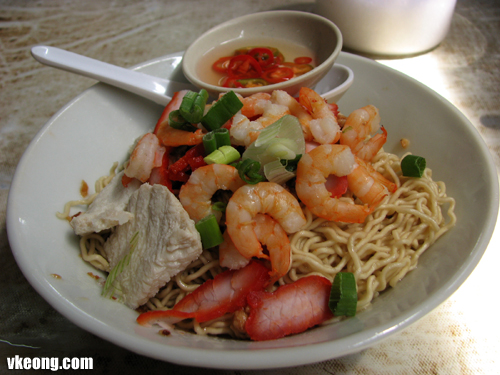SPECIAL FOOD OF SARAWAK
LAKSA
Laksa typically consists of rice noodles in a thick, gritty gravy made from either coconut milk and curry paste or tamarind fruit and fish, depending on the locale. Lemongrass, garlic, shallots, chili, fish or shrimp, and a long list of other seasonings blend flawlessly for a complex taste. Optional lime helps to counter the fishy taste and adds a citrus zing.
Laksa is the quintessential fusion of Chinese and Malay cuisine; a must-try for any traveler in Southeast Asia.
The Origins of Laksa
Laksa is generally thought to be a creation of the Chinese who immigrated to the British Straits in Malaysia during the 15th century. Known as the Peranakan, most of the immigrants were of Hokkien descent and came from South China.
Even the origin of the word "laksa" is debated. The word lakhshah denotes a type of noodle in Hindi; however, laksa sounds similar to a Chinese word meaning "spicy sand" - fitting because of laksa's gritty texture.

LAKSA SARAWAK
taken in : http://goseasia.about.com/od/malaysianculturepeople/a/laksa_noodles.htm
MEE KOLOK
Mee Kolok was originally not the original natives of Sarawak food. Mee Kolok is those foods brought by migrant The Sarawak Chinese community migrated to The Sarawak. As a result many Kolok mee is served in all the chinese food storein the state. Mee Mee Kolok between popular self in Sarawak, and is well known among the Malays, however not manyMalay food outlets serving Kolok mee and there is a slight modification of taste.
There are several terms that refer to Kolok mee.
There are several terms that refer to Kolok mee.
(i) Mee Kolok (Malay)
(ii) Kampua (Chinese)
(iii) Outline noodles / 'dry noodles' (Iban)

MEE KOLOK
MEE KUCHING AND KUEH TIAW TOMATO
Both types of noodles are readily available in Chinese food stores, and restaurant or food
courts (halal) in the shopping complex.
For Kuching Noodles, noodles are widely available in Kuching and it also known as Mee Wire.
This is due to hard and crunchy noodles when served.

MEE WIRE
KUEH TIAW TOMATO
MANOK PANSOH
Pansoh Manok in which chicken is a type of food cooked in bamboo. This food is traditional food of the Iban community. Supplying the same manner as provided in the peninsula bamboo cylinder.
'Manok' means chicken and 'Pansoh' means cooked in bamboo. In the Iban language, known as 'Manuk Pansuh' or 'Manuk Lulun'. Due to this method of cooking originated from the Iban community, then other ingredients other poultry such as pork and fish prepared in the same manner.
'Manok' means chicken and 'Pansoh' means cooked in bamboo. In the Iban language, known as 'Manuk Pansuh' or 'Manuk Lulun'. Due to this method of cooking originated from the Iban community, then other ingredients other poultry such as pork and fish prepared in the same manner.

WAY TO DO MANOK PANSOH

MANOK PANSOH THAT ALREADY COOK
TEBALOI
Tebaloi is a type of biscuit which is a kind of consolation traditional Melanau food. Tebaloi main ingredient is a consolation. These foods are widely exported to other countries and is one of the traditional food The Sarawak which are in high demand.

VIEW OF TEBALOI WHEN IT ALREADY PACK
PROCESS HOW TO CUT THE TEBALOI
KEK LAPIS SARAWAK
Sarawak layer cake is a cake / pastry popular in Sarawak. These cakes are very popular during celebrations in Sarawak eg Eid, Christmas, Gawai Dayak, and do not miss the Chinese New Year. This cake has dozens of patterns or pattern and each type has its own unique name created by people who first created the pattern or pattern cake. Prices also depend on the large cake, patterns and difficulty making the cake. So the bigger, the more the pattern, the more difficult to make the cake, the more expensive the price of the cake.
For example: type layer cake 'roll' with the usual pattern, size 8 "x 8" x 4 ", 3.5 kg priced at RM198.00 each. (Price based on one layer cake seller)
Here are some of the types and names layer cake::
For example: type layer cake 'roll' with the usual pattern, size 8 "x 8" x 4 ", 3.5 kg priced at RM198.00 each. (Price based on one layer cake seller)
Here are some of the types and names layer cake::
TYPES OF ROLL
 |
| i. Kipas |
 |
| ii. Kristal |
 |
| iii. Bintik-bintik |
 |
| iv. Batik Jiwa |
COMMON TYPE
 |
| i. Aiskrim Anika |
 |
| ii. Ketupat |
 |
| iii. Tulip |
 |
| iv. Pua Kumba |
taken in : http://kuchinghereicome.blogspot.com/2013/07/traditional-food-sarawak.html

- See more at: http://www.asiarooms.com/en/community/blog/5-famous-foods-in-kuching/#sthash.hhnUwsUq.dpuf

UMAI
Umai is a raw fish salad that’s particularly popular amongst the fishermen of Melanau, an ethnic group in Sarawak. It’s made with freshly-caught fish – typically mackerel, umpirang or bawal hitam – that’s been sliced into thin slivers. Additional ingredients include onions, chilli, salt and a satisfactory squeeze of lime or assam juice that gives the salad its signature sour taste. This interesting side dish is best enjoyed with a serving of white rice.

Umai, a popular raw fish salad from Kuching.
MIDIN
As no diet would be balanced without your greens, I’ve decided to include the Midin in this listing. This delicious yet nutritious dish is prepared by stir-frying a species of fern that can only be found in the jungles of Sarawak, and it’s unique because it remains enjoyably crunchy even after it’s been cooked, unlike other vegetables that usually turn soft. Garlic, ginger or shrimp paste is introduced to add flavour to the dish.

Midin that has been stir-fried with sambal belacan.
- See more at: http://www.asiarooms.com/en/community/blog/5-famous-foods-in-kuching/#sthash.hhnUwsUq.dpuf
No comments:
Post a Comment